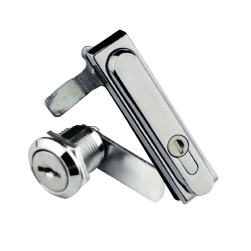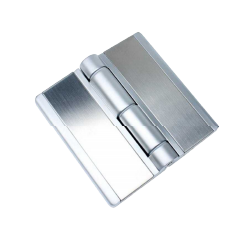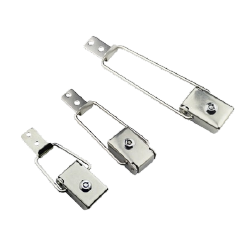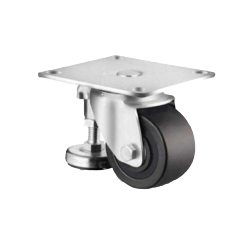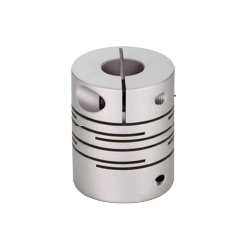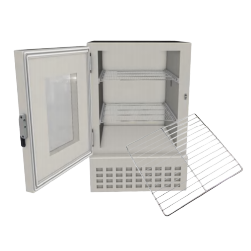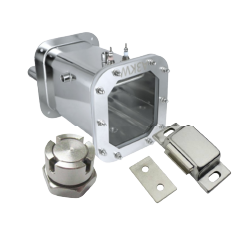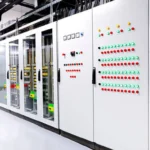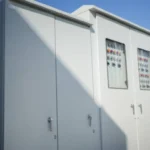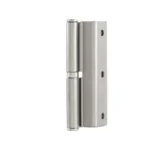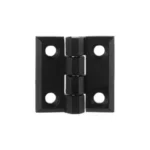Introduction
In the industrial design and manufacturing world, parts are evaluated based on how well they can work under harsh conditions. The industrial hinge is one of the most basic of these. It is not a mere commodity, but a finely tuned mechanism, the key point of balance on which the safety, accessibility, and durability of a greater system hinges. Its performance is non-negotiable. This guide offers a methodical analysis of industrial hinges, including their defining features, major types, material compositions, and major uses. It is meant to provide engineers, designers and procurement specialists with the information to choose the right hinge to suit a particular application.

What Defines an Industrial Hinge?
The main difference between an industrial and a residential hinge is the principles of its design and the strictness of its construction. A residential hinge is mainly focused on the domestic level of frequency of use and aesthetics, whereas an industrial hinge is specified to a quantifiable level of performance.
The initial distinguishing feature is the load-bearing capacity. Industrial hinges are designed to carry heavy loads, frequently moving loads,and much more than those in residential applications. This includes heavier materials, stronger pin and knuckle construction and tight manufacturing tolerances to avoid sag and failure with age. For instance, a heavy-duty hinge might support hundreds or even thousands of lbs in industrial doors.
Second is material integrity and environmental resilience. An industrial hinge should be able to work in conditions that could be very hot, wet, corrosive or salty air. These environmental challenges are directly addressed by the material selection, whether that is particular grades of stainless steel, coated carbon steel, or high-performance polymers.
Lastly, an industrial hinge is characterized by its anticipated life cycle. It is intended for high-frequency usage and is expected to last thousands, or even tens of thousands, of cycles with little wear, degradation of performance, or loss of positional accuracy. This longevity is achieved through careful design, material and manufacturing decisions that make it a dependable part of a mission-critical system, ensuring years of dependable service and efficient product delivery.
Common Types of Industrial Hinges Explained
Choosing a proper hinge starts with the knowledge of the main categories, each of which is characterized by a specific structure and purpose.
| Hinge Type | Key Features | Typical Applications |
| Butt Hinge | Simple pivot, strong, easy to install | Doors, cabinets, medium-duty enclosures |
| Piano Hinge | Full-length load distribution, high stability | Long doors, electrical cabinets, partitions |
| Concealed Hinge | Hidden installation, tamper-proof, clean aesthetics | Security enclosures, architectural panels |
| Detachable Hinge | Lift-off design for quick removal | Modular equipment, maintenance access |
| Offset Hinge | Increased clearance, 180° swing | Machinery, medical devices, wide access doors |
| Heavy-Duty Hinge | Reinforced for extreme loads, may include bearings | Vault doors, armored hatches, industrial gates |
| Weld-On Hinge | Permanent weld connection, tamper-resistant | Security cages, shipping containers |
| Spring Hinge | Auto-closing/opening with adjustable tension | Fire doors, safety gates, cleanroom panels |
| Torque Hinge | Friction-based, position-holding capability | Displays, control panels, medical equipment |
Butt Hinges
One of the most popular and familiar ones is the butt hinge. It is made up of two rectangular leaves, or plates, connected by a central pin passing through a sequence of interlocking knuckles. When folded, the two leaves butt together, forming a tight profile. Butt hinges are appreciated in industrial use because of their strength and simple fitting on the edge of a door and the matching frame. They are defined in a broad scope of applications, including small access panels, medium-duty enclosure doors, where a simple, robust pivot is needed.
Piano Hinges
Piano hinges are also called continuous hinges, and are a variant of the butt hinge, distinguished by their extreme length. They are made to run the full length of the door or panel on which they are attached. The main mechanical benefit of this design is the uniform distribution of the load throughout the entire height of the point of connection. This reduces stress on any one point and avoids warping or sagging, which is typical of heavy or long panels. Piano hinges are best suited for large cabinet doors, tool chests, electrical enclosure doors, and folding partitions.
Concealed Hinges
The concealed hinges are designed in such a way that they are completely invisible from the outside when the door or panel is closed. This is done by using complicated multi-pivot or cup-and-arm hinge designs which are attached to the inside of the door and the frame of a cabinet. Their main advantage in industrial settings is security and beauty. They also avoid external hinge points, so they cannot be tampered with and provide a clean, seamless exterior, which is essential in secure enclosures, architectural panels, and high-design machinery. They also eliminate the protrusions on the outside that may be snag points in a crowded setting.
Detachable Hinges
A detachable hinge is a broad functional category that describes any hinge that enables a door or panel to be removed from its frame without the need to unscrew the hinge leaves. The most common of this group is the lift-off hinge, commonly referred to as a flag hinge. This design is made up of a male leaf that has a fixed axis pin and a female leaf that has a hollow barrel. The door is just pulled vertically off the frame to separate. This feature is essential where applications need frequent or quick access to perform maintenance, install equipment or change modules, e.g. in modular machinery and large electrical cabinets. They are produced in left hand and right hand.
Offset Hinges
Offset hinges are made with a particular geometry that moves the pivot point off the face of the frame. This offset enables the door to swing fully out of the way of the door opening when the door is opened to 180 degrees, maximizing the width of the clearance. This is an important aspect in access to machinery, medical equipment, and any enclosure where free access is required to move large parts or people in and out of the area. One of the most important specifications is the degree of offset, which is the distance the door will be offset to the frame when it is open.
Heavy-Duty Hinges
Heavy-duty is not a form factor but a performance attribute. A heavy-duty hinge may be a butt hinge, a weld-on hinge or other type, but is specifically designed to handle heavy doors and extreme loads. These heavy duty hinges have much thicker leaf material, larger and stronger pin diameters and frequently include bearings, typically bronze or stainless steel bushings, to minimize friction and wear at the extreme weight. They are designed to be used on large industrial gates, vault doors, armored vehicle hatches, and any use where the weight of the door is too heavy to be supported by standard hinges.
Weld-On Hinges
Weld-on hinges are made to be permanently attached directly to metal surfaces through welding. They are usually two halves of a hinge with no mounting holes, and are usually barrel shaped. They are made of weldable material, usually steel or stainless steel. The main benefit is that it is stronger; a well-welded hinge is part of the door and frame, and this makes a very strong and tamper-proof joint. This qualifies them as the default option when it comes to heavy gates, security cages, shipping containers, and heavy-duty machinery frames.
Spring Hinges
Spring hinges have a spring mechanism built into the barrel and give automatic closing or opening action. A single-acting spring hinge will automatically close a door when it is in the open position, a requirement of fire doors, safety gates, and industrial enclosures that need to be closed. The door can swing both ways and be brought back to a closed center position with a double-acting spring hinge. The spring tension can usually be adjusted to regulate the closing force and speed.
Torque Hinges
Torque hinges are also called friction hinges or position control hinges and are designed to resist pivoting. This resistance enables a door or panel to be held in any position at any angle without the use of a secondary support such as a gas strut or lid stay. A friction mechanism set in the factory creates the torque in the hinge barrel. They are essential in applications such as laptop screens, overhead display panels, machine control panels and medical equipment where accurate and stable positioning is needed.

Common Types of Materials Used in Industrial Hinges
The performance and lifespan of an industrial hinge are intrinsically linked to its material composition.
Stainless Steel
Industrial hinges are made of stainless steel because of the corrosion resistance and strength of this material. Its resistance is due to chromium content that forms a passive, self-healing oxide layer on the surface. The most common is grade 304, which has good corrosion resistance in normal atmospheric conditions. In marine, chemical, or other highly corrosive applications, Grade 316 is used; molybdenum added to this grade gives it better resistance to chlorides.
Aluminum
Aluminum is appreciated due to its strength to weight ratio and inherent corrosion resistance. It is much lighter than steel and therefore it is suitable for transportation and aerospace, where weight is a major consideration. It is not as strong as steel, but its alloys can be designed to give high load-bearing capacity. It also develops a protective oxide coating naturally and this resistance can be increased by anodizing.
Brass
Brass is a mixture of copper and zinc, which provides good strength and high corrosion resistance. It is also inherently low-friction, which may be beneficial to the smooth functioning of the hinge. Its characteristic golden look is occasionally given as a specification on aesthetic grounds, but its main industrial worth is its strength and corrosion resistance in water-based conditions.
Zinc Alloy
Zinc alloys are frequently used in die-casting processes to create hinges with complex shapes and features. They provide a reasonable combination of strength, dimensional stability, and cost. Zinc hinges are nearly always coated or plated, usually with chrome or black powder coat, to give the required corrosion protection and a finished look. Often used is Zamak, a family of zinc alloys, known for its good casting properties and robustness.
Plastics
In special applications, hinges are made of high-performance polymers, or plastics. They are naturally corrosion resistant, light and may be electrically non-conductive. Such materials as nylon, acetal, and polypropylene are chosen due to their particular characteristics, e.g., chemical resistance or high wear resistance. They are used in medical equipment, food processing equipment, and lightweight enclosures where metal is not appropriate.
Key Applications of Industrial Hinges
Industrial hinges are integral to the function and safety of equipment across a multitude of sectors, meeting the varied demands of our esteemed clients.
Electrical and Industrial Enclosures
These enclosures safeguard delicate electronic parts against dust, moisture and impact. Hinges should also guarantee that the door seals properly to retain NEMA or IP (Ingress Protection) ratings. Security is usually achieved with concealed hinges, whereas detachable hinges make it easy to remove the door during assembly or maintenance. These are critical for industrial applications.
Machinery and Equipment Access Panels
Providing safe and reliable access to the internal workings of machinery is critical for maintenance and operation. Torque hinges are applied to keep inspection panels open, and heavy-duty hinges are applied to support large and heavy guards. The selection of hinge has a direct effect on the safety of the operator and the uptime of the equipment.
Heavy-Duty Doors & Hatches
This covers such applications as shipping containers, acoustic doors, cold storage doors and hatches on marine vessels or off-road vehicles. Such doors are heavy and they are usually thickly sealed. The high loads necessitate heavy-duty butt hinges, weld-on hinges and offset hinges to give the required clearance and leverage.
Transportation & Vehicles
Hinges in specialty vehicles such as ambulances, fire trucks, and RVs have to endure continuous vibration and dynamic loads. To save weight, aluminum hinges are used, and heavy duty stainless steel piano hinges are used on long compartment doors to avoid sagging and keep them weathertight.
Food, Medical & Cleanroom Equipment
The main concern in such applications is hygiene. Hinges must be made from materials like 316 stainless steel that can withstand aggressive cleaning and sanitizing agents. Designs with smooth, crevice-free surfaces are preferred to prevent the buildup of bacteria.
HVAC and Energy Systems
Industrial hinges are needed in large air handling units, power generation cabinets, and other alternative energy equipment (such as solar panel arrays or battery enclosures). These hinges have to withstand decades of outdoor exposure, including UV radiation and extreme temperatures. Stainless steel and coated steel are common, especially heavy-duty coated steel and corrosion-resistant stainless steel.

Key Factors to Consider When Selecting The Right Industrial Hinges
A systematic approach to hinge selection is crucial to ensure performance, safety, and longevity, and find the best solution for your needs.
Load Capacity
This is the most important aspect. You have to calculate the static load (weight of the door) and any dynamic loads. Hinge manufacturers give load bearing capacities on their hinges, usually on the assumption of two or three hinges per door. Never forget a safety factor, and choose a hinge whose capacity is well above your calculated maximum load.
Opening Angle
Find out the necessary level of opening. Standard hinges provide 90, 180 or even 270 degrees of rotation. Special concealed hinges can have more complicated opening paths. Make sure that the chosen hinge will give you the access you require and the door will not hit adjacent objects.
Torque Function
In case you require a panel to remain open without a secondary support, you will require a torque hinge. Take the force to hold the panel. The torque rating is given by the manufacturers in Newton-meters (N-m) or pound-inches (lbf-in). The right value of torque is essential to user experience and safety.
Material Corrosion Resistance
Evaluate the working environment. Will the hinge be subjected to moisture, salt spray, chemicals or cleaning agents? This will determine the choice of material. For outdoor use, at least 304 stainless steel should be used. In the case of marine or highly corrosive conditions, 316 stainless steel is necessary. Salt spray test data (e.g., ASTM B117) may be used to give a quantitative indication of the corrosion resistance of a hinge, frequently expressed in hours.
Finishes and Coatings
Coatings offer additional protection and may be aesthetically valuable. Powder coating is a long-lasting solution for steel and aluminum, and it offers great resistance to corrosion and scratches. Steel and zinc alloy hinges are often plated with zinc or chrome. The finish is as important as the material it is based on.
Frequency of Use
How many times will the door or panel open and close? An access panel with a high use can experience thousands of cycles annually. In these applications, choose hinges that have high cycle ratings and such characteristics as premium quality bearings or hardened pins to reduce wear. A low-use maintenance panel might not need such a heavy specification.
Temperature
Take into account the ambient operating temperature range. Plastics may be brittle in very cold temperatures and soft in very hot temperatures. Ordinary lubricants can break down at high or low temperatures. For high-temperature applications, such as on ovens or engine compartments, all-metal hinges (steel or stainless steel) with appropriate high-temperature grease or no lubricant are required.
Security Features
Security is a priority in case the enclosure is protecting valuable or dangerous equipment. Select hidden hinges to prevent external tampering. Other features that increase resistance to forced entry are non-removable pins or security studs.
Mounting Style
The hinge should be able to fit your door and frame material and construction. Options include:
- Surface-mounted: Screwed or bolted on to the surface.
- Weld-on: Welded permanently to be as strong as possible.
- Concealed/Mortised: Fitted in recesses cut in the door and frame. Choose the style that fits your manufacturing process and strength needs and the specific installation situation.
Certifications and Standards
In some applications, industry standards must be met. This can be RoHS (Restriction of Hazardous Substances), REACH, or particular NEMA/IP ratings on enclosures. In the case of fire doors, the hinges should be of the right UL rating. The use of a manufacturer that offers certified products will guarantee compliance and quality.
KUNLONG: Your Reliable Industrial Hinge Manufacturer

Selecting the right hinge requires partnership with a manufacturer that possesses deep engineering expertise and a commitment to quality. Founded in 2005, KUNLONG specializes in manufacturing high-performance industrial hinges and specialty hinges for demanding applications. With deep expertise in materials and engineering, we support industries with reliable, precision-made components, operating with an everlasting innovation mindset.
We offer hinges in an extensive range of industrial hinges made from certified the finest quality materials, including stainless steel, aluminum, zinc alloy, iron, rubber, and silicone. All materials comply with SGS and RoHS standards. Our products are available in 30+ colors and over 10 surface finishes to meet diverse design needs.
Key features include strong load capacity, corrosion resistance (salt spray test up to 1000 hours), and optional functions such as anti-bacterial coatings, vibration resistance, and high/low temperature tolerance (-70°C to 260°C). Our hinges are designed for high stress environments and are incredibly durable.
Each batch undergoes 15 quality checks, with precision controlled within 0.0005mm. We hold 108 patents and are certified under ISO9001, CE, and other international standards.
KUNLONG provides free service technical consultation, online 3D CAD downloads, and fast response within 12 hours to customer feedback. With over 700 wide variety of custom industrial hinges solutions delivered, we’re more than a supplier—we’re your technical partner, ensuring that the chosen component delivers optimal performance, reliability, and value for the entire lifecycle of their product. We pride ourselves on excellent customer service and efficient product delivery after order placement
Contact us today to find the hinge solution that fits your product perfectly, providing dependable quality.
Installation Tips and Maintenance Best Practices for Industrial Hinges
The correct installation and maintenance are crucial to the achievement of the full life of an industrial hinge.
Installation:
- Alignment: The most crucial thing about installation is that the hinges should be perfectly aligned. Hinges that are not aligned will experience extreme stress and will bind, wear out, and fail prematurely. Utilize a laser level or an accurate straight edge.
- Proper Fasteners: Fasteners should be of the size and material suggested by the hinge manufacturer. A typical point of failure is the use of undersized or wrong-grade fasteners.
- Support: Properly support the weight of the door when installing it to avoid straining the initial few fasteners.
- Welding: With weld-on hinges, the proper welding rod and method should be used to provide a full-penetration weld on the base materials.
Maintenance:
- Lubrication: Moving parts should be periodically lubricated, particularly on high-frequency doors, unless the hinge is self-lubricating. Apply the recommended type of lubricant to the material and environment.
- Inspection: Hinges should be inspected regularly to check wear, damage or corrosion. Inspect the hinge pin wear, elongation of screw holes, and cracking.
- Cleaning: Hinges should be kept clean, particularly in dirty or corrosive conditions. This avoids abrasive particles that increase wear.
- Fastener Check: Check and tighten mounting fasteners periodically since vibration may loosen them over time.
Conclusion
The industrial hinge is a reminder of the fact that the functioning of a complex system usually depends on the quality of its most basic elements. A systematic selection process, which is a process that takes into account load, environment, function and material is not optional but a must. With knowledge of the different types of hinges and the important parameters that determine their performance, engineers and designers can make informed choices that would improve the safety, durability, and operational excellence of their equipment. Choosing the right hinge is a foundational step in quality engineering.

